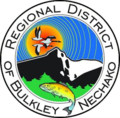Top Qs
Timeline
Chat
Perspective
Regional District of Bulkley-Nechako
Regional district in British Columbia, Canada From Wikipedia, the free encyclopedia
Remove ads
The Regional District of Bulkley–Nechako (RDBN) is a regional district in the Canadian province of British Columbia, Canada. As of the 2021 census, the population was 37,737. The area is 73,419.01 square kilometres. The regional district offices are in Burns Lake.
Remove ads
Its geographical components are the Bulkley Valley, the northern part of the Nechako Country, and the Omineca Country, including portions of the Hazelton Mountains and Omineca Mountains in the west and north of the regional district, respectively. The dominant landform is the Nechako Plateau. Neighbouring regional districts are the Kitimat-Stikine, Central Coast, Cariboo, Fraser-Fort George, and Peace River Regional Districts; on its north the boundary with the southern edge of the remote Stikine Region is separated from the Bulkley–Nechako Regional District by the 56th parallel north. The boundaries of the regional district near-entirely coincide with the territory of the Dakelh or Carrier peoples, and also some of that of the Dunneza (Beaver), but their reserves and governments lie outside the regional district system. Roughly identical in area to the old New Caledonia fur district in the days of the North West Company, it is still sometimes referenced as New Caledonia, but while trapping continues in some area, its economy is now based in forestry, mining, tourism (mostly ranching in southern areas).
Remove ads
Municipalities
Demographics
Summarize
Perspective
As a census division in the 2021 Census of Population conducted by Statistics Canada, the Regional District of Bulkley-Nechako had a population of 37,737 living in 15,399 of its 17,618 total private dwellings, a change of −0.4% from its 2016 population of 37,896. With a land area of 73,203.22 km2 (28,263.92 sq mi), it had a population density of 0.5/km2 (1.3/sq mi) in 2021.[2]
Remove ads
Notes
References
External links
Wikiwand - on
Seamless Wikipedia browsing. On steroids.
Remove ads



